Three Natural Bridges is located in Xiannüshan Town, Wulong District, Chongqing. It is a World Natural Heritage site, a national 5A-level tourist attraction, and a core part of the Wulong karst landform. The total area of the scenic area is approximately 4.7 square kilometers, with three magnificent and imposing natural stone arch bridges as the core landscapes, namely Tianlong Bridge, Qinglong Bridge, and Heilong Bridge. These three bridges are arranged longitudinally, spanning parallel over the Yangshui River Gorge, connecting the mountains on both sides, forming the unique landform of "three bridges flanking two pits". Such a group of natural bridges formed by carbonate rocks is extremely rare worldwide, with high geological research value and tourism appreciation value. The scenic area also includes various karst landforms such as sinkholes, karst caves, and gorges, with a high vegetation coverage rate and an excellent ecological environment. It became widely known for being the location for the film "Curse of the Golden Flower".
Historical Culture
As a naturally formed geological wonder, the history of Three Natural Bridges is more reflected in the long process of geological evolution. According to geological experts, the formation of Three Natural Bridges has gone through about 200 million years. It was gradually formed by the weathering, dissolution, and collapse of carbonate rocks over long geological ages, witnessing the evolution history of the Earth's crustal movement and karst landforms.
In local folklore, Three Natural Bridges are closely related to ancient heroes, with many myths and stories about the origin of the three bridges. These stories reflect the local people's awe and imagination of natural wonders and add a strong cultural color to the scenic area. In addition, under Tianlong Bridge in the scenic area, there is an ancient building with a Tang Dynasty style - Tianfu Post House. This post house was first built in the Tang Dynasty and was an important post for official information transmission between ancient Fuzhou and Qianzhou. The existing building is reconstructed according to historical records, becoming an important node connecting natural landscapes and historical humanities.
Main Attractions
Tianlong Bridge
Tianlong Bridge is the first and the widest among the Three Natural Bridges. It is 235 meters high, 150 meters thick, 147 meters wide, and 340 meters long. On the stone walls on both sides of the bridge deck, there are many natural caves formed by dissolution, and some of these caves contain stalactites and stalagmites. The arch of Tianlong Bridge is irregularly rectangular with a span of about 50 meters. Under the bridge is Tianlong Pit, which is about 100 meters deep, with streams and vegetation at the bottom. Tianfu Post House is located under the arch of Tianlong Bridge, at the bottom of Tianlong Pit, surrounded by steep rock walls, making it a popular photo spot for tourists.
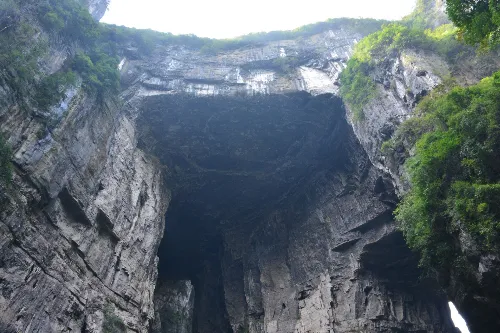
Qinglong Bridge
Qinglong Bridge is the second of the Three Natural Bridges. It gets its name because after rain, the rock walls on both sides of the bridge often have bluish-black water stains, resembling a green dragon. It is 281 meters high, the tallest among the three bridges, with a thickness of 103 meters, a width of 124 meters, and a length of 280 meters. Its arch is arc-shaped with a span of about 102 meters and an arch height of about 116 meters, with a beautiful and magnificent shape. There is a naturally formed crack above the bridge deck called "Yixiantian" (a strip of sky), and sunlight shines through the crack, creating a unique light and shadow effect on the bridge deck. Under the bridge is Qinglong Pit, with dense vegetation and gurgling streams, creating a quiet environment.
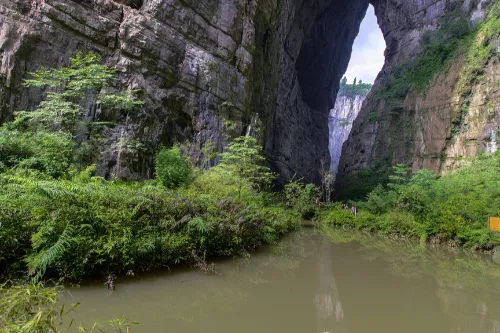
Heilong Bridge
Heilong Bridge is the third bridge among the Three Natural Bridges. It stands 223 meters high, with a thickness of 107 meters, a width of 193 meters, and a length of 228 meters. Due to the dim light inside the bridge cave, which remains in shadow all year round, it resembles a hidden black dragon, hence the name Heilong Bridge (Black Dragon Bridge). A distinctive feature of Heilong Bridge is the four naturally formed springs in its cave, namely "Pearl Spring", "Fog Spring", "Thread Spring", and "Three-tiered Spring". The spring water gushes out from the rock walls in various forms—some falling like scattered pearls, others drifting like mist—adding a vivid and lively beauty to the bridge. Below the bridge lies Heilong Pit, whose bottom is relatively flat, making it an ideal spot for tourists to rest and enjoy the scenery.
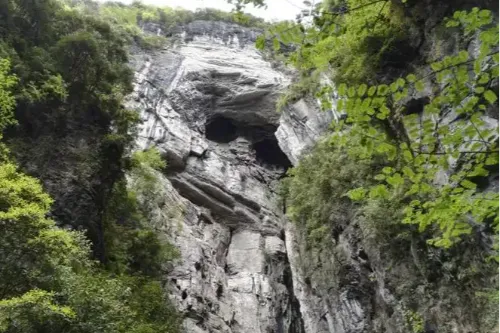
Tianfu Post House
Tianfu Post House is located at the bottom of Tianlong Pit under Tianlong Bridge. It is a group of ancient buildings reconstructed in the Tang Dynasty style, covering an area of about 500 square meters, consisting of the main post house, stables, kitchen, and other parts. The building materials of the post house mostly use local stone and wood, with blue tiles covering the roof and rammed earth walls, reproducing the style of ancient post houses. The post house displays exhibits such as ancient weapons, documents, and daily necessities, vividly showing the functions and living scenes of ancient post houses. It was once an important location for the film "Curse of the Golden Flower", attracting many fans to visit.
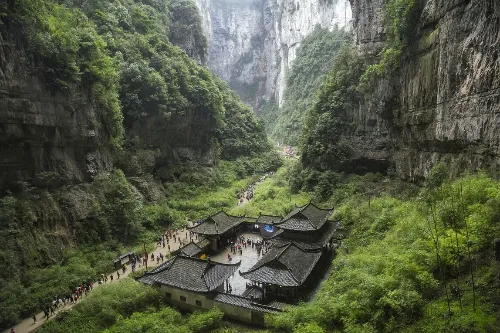
Tianlong Revolving Ladder
Asia's first 360-degree rotating elevator, with a vertical height of 135.85 meters and an operating height of 115 meters. It uses three double-decker panoramic sightseeing elevators running in parallel and separately, each carrying 52 passengers at a time, with an operating speed of 3 meters per second. The three elevators can transport up to 15,000 passengers per day when running simultaneously. The Tianlong Revolving Ladder has a rotating double-decker car that rotates 360 degrees automatically and slowly during operation, allowing tourists to enjoy the karst natural scenery of Three Natural Bridges from different angles, adding functions such as bird's-eye view, overlooking, and distant viewing. Compared with vertical elevators, the rotating lifting is more comfortable, like floating in the clouds.
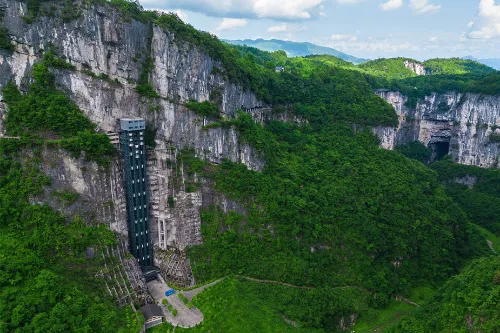
Glass Viewing Platform
The glass viewing platform is built on the cliff of Qinglong Bridge, with an overhanging length of about 28 meters and a vertical height of 280 meters from the bottom of the pit. It is paved with fully transparent glass, allowing visitors to enjoy a 360-degree view of the karst wonder of "three bridges flanking two pits" while standing on it.

Tour Route
After entering the scenic area, tourists first take the sightseeing elevator down to the bottom of Tianlong Pit (the vertical height of the elevator is about 80 meters). After exiting the elevator, they first reach the vicinity of Tianlong Bridge, visit Tianfu Post House to feel the historical atmosphere of the ancient post house, then enjoy the grandeur of Tianlong Bridge, and pass through the arch of Tianlong Bridge to enter Qinglong Pit. Walk along the trail in Qinglong Pit to closely appreciate the steepness and beauty of Qinglong Bridge, pass by landscapes such as "Yixiantian", then cross Qinglong Bridge to enter Heilong Pit. In Heilong Pit, focus on viewing the four springs of Heilong Bridge to feel the vitality of the spring water, and finally walk along the trail or take a battery car back to the scenic area exit. The total length of the tour route is about 3.5 kilometers, and the walking time is about 2.5-3 hours. There are rest pavilions and signposts along the way to facilitate tourists' visit.
Tour Suggestions
- It is recommended to arrange the visiting time between 9 am and 3 pm, when the light is suitable for viewing and photographing the landscapes.
- The trails in the scenic area are mostly stone steps, and some sections are steep. It is recommended to wear comfortable sports shoes and avoid high heels.
- In summer, the temperature in the scenic area is 3-5℃ lower than that outside, and the humidity is high. It is recommended to bring a thin coat; in winter, the temperature is low, so keep warm.
- You can rent an electronic interpreter (rental fee is about 20 yuan per unit) to learn about the geological origin and historical and cultural background of the scenic spots.
- There are few catering spots in the scenic area. It is recommended to bring a small amount of drinking water and dry food. After the visit, you can go to Xiannüshan Town to taste local specialties such as Wanwan mutton and Jiangkou fish.
- If you want to avoid the peak tourist season, you can choose to go on weekdays. There are many tourists on holidays, and you may need to queue up for the sightseeing elevator.
Matters Needing Attention
- Smoking and littering are strictly prohibited in the scenic area, and you must abide by the ecological protection regulations of the scenic area.
- During the tour, you must walk along the designated trails and must not enter unopened areas without permission to avoid danger.
- On rainy days, the trails in the scenic area are slippery. Walk carefully and pay attention to anti-slip; some sections may have falling rocks, so pay attention to warning signs.
- Take good care of the cultural relics and natural landscapes in the scenic area. Do not scribble or carve on rock walls or buildings.
- Tourists with children and the elderly must take good care of their companions to avoid getting lost or having accidents.
- Mobile phone signals in some areas of the scenic area are weak. It is recommended to keep in touch with companions and avoid acting alone.
Transportation
- Self-driving: Starting from downtown Chongqing, drive along Baomao Expressway (G65), exit at Wulong Interchange, then go to Three Natural Bridges Scenic Area along Xiannüshan Tourism Express Line. The total distance is about 180 kilometers, and the driving time is about 2.5 hours. The scenic area has a parking lot with a parking fee of 5 yuan per hour.
- Public transportation: Take a long-distance bus to Wulong District at Chongqing Longtousi Bus Station or Sigongli Bus Station (about one bus every 30 minutes, fare about 60 yuan). After arriving at Wulong Bus Station, transfer to the tourist bus to Three Natural Bridges Scenic Area (about one bus every 30 minutes, fare about 10 yuan), with a driving time of about 40 minutes.
- Tourist line: Some travel agencies in downtown Chongqing have opened a one-day tour line to Three Natural Bridges, including transportation, tickets, and guide services. You can consult and register in advance.
- Train: Take the high-speed rail from Chongqing North Station to Wulong Station (about 1 hour, fare about 55 yuan), then take a taxi to Wulong Bus Station after getting off, and then transfer to the tourist bus to the scenic area.
Opening Hours
The opening hours will be adjusted according to the season. In the peak season (March 1 - October 31), the opening hours are 8:00-17:30; in the off-season (November 1 - February 28 of the next year), the opening hours are 8:30-17:00. The scenic area will stop selling tickets and admitting visitors 1 hour before closing. Tourists are advised to arrange their visiting time reasonably. In addition, the opening hours may be temporarily adjusted in case of extreme weather or special events. It is recommended to check the official website of the scenic area or call the consultation hotline for confirmation before traveling.
Tickets
The package ticket is 155 yuan per person.
You can search for the official WeChat public account of the scenic area, "武隆景区", to get the latest news or buy tickets online.
Online Booking
Click here to jump to the Trip.com ticketing platform for ticket purchase.


